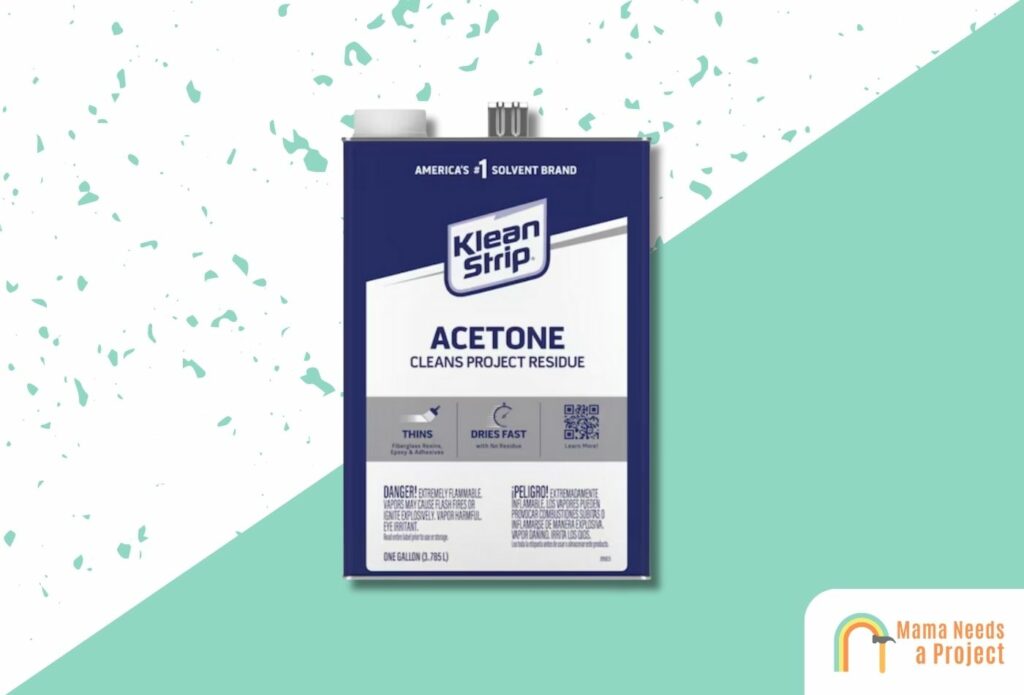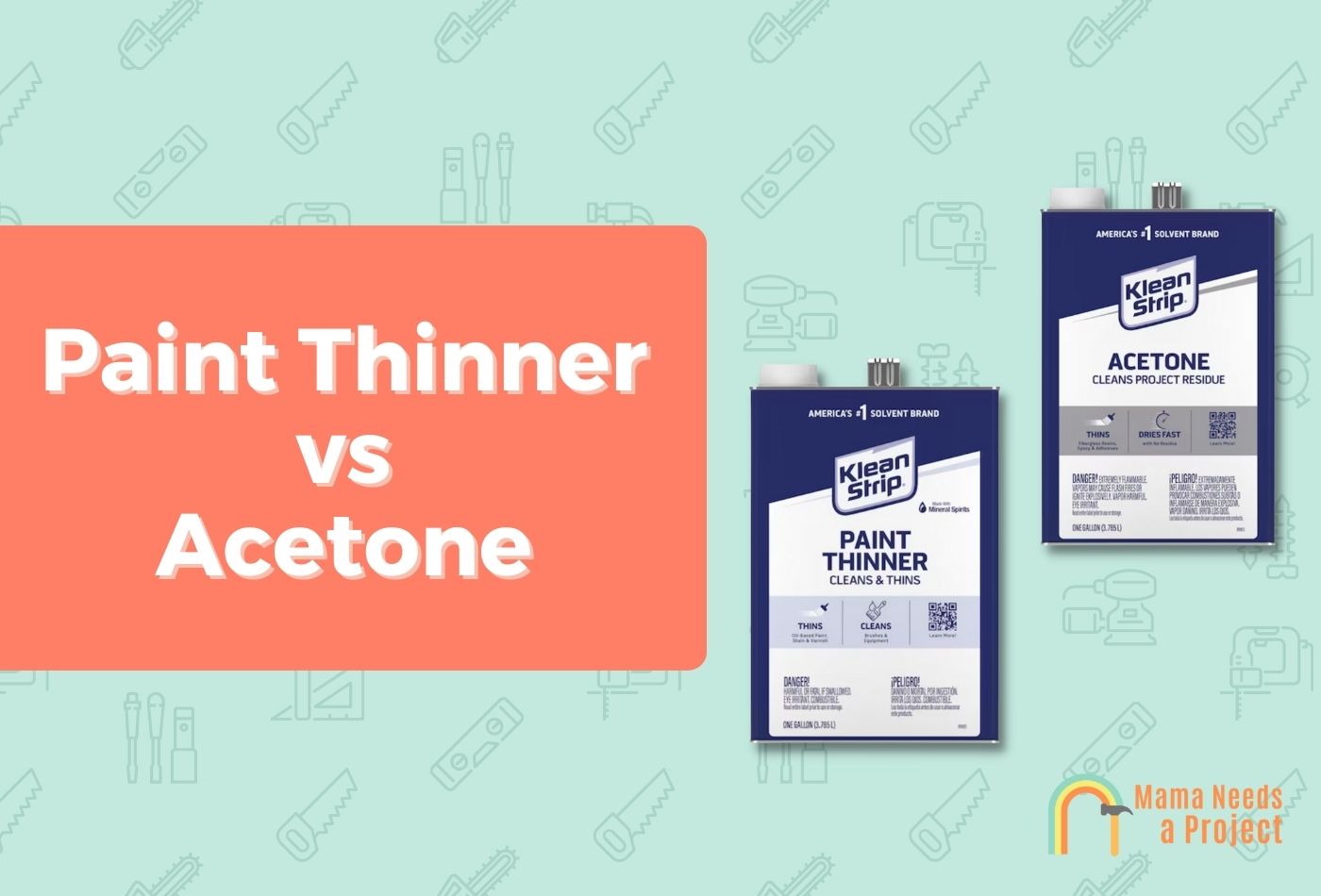Paint Thinner vs Acetone: Which is Better? (Ultimate Guide)
Whether you’re a painter, cosmetologist, or woodworker that uses solvents, it’s important to understand the difference between paint thinner and acetone. Although these liquids have similar chemical compositions and ingredients, they are not the same and have different uses.
It’s important to understand how these materials are different and how they work so that you can choose the option that’s right for you. For instance, you’ll need a different solvent if you’re thinning paint versus disinfecting something.
If you’re having trouble understanding the difference between paint thinner and acetone, you’ve come to the right place. In this article, I’ll delve into the similarities and differences between these solvents and explain how they’re typically used.
What is Acetone?

Acetone is a highly potent and flammable liquid used as a solvent or ingredient in many industries. Because of its chemical composition, acetone is also known as methyl ethyl ketone and many other scientific names that are seemingly impossible to pronounce.
Although acetone is clear and colorless, it has a very pungent odor and taste and is toxic if you accidentally ingest it. It’s the main ingredient in nail polish remover and has the ability to mix well with water.
Common Acetone Uses
Because it’s the main ingredient in nail polish removers, acetone is best known for its ability to remove nail polish. However, painters love it for these same reasons because acetone can clean paint brushes, paint spills, and painting tools.
In addition to its uses in the painting and beauty and pharmaceutical industries, here are a few other uses for acetone.
- Textile Industry as a solvent in producing plastics, polyester resin, synthetic fabrics, and other textiles.
- Photography, where it gets diluted with water to help develop film and clean film stocks.
- Healthcare and Laboratories to kill germs and sterilize tools, equipment, and metal surfaces.
What Is Paint Thinner?

As the name implies, paint thinner is a liquid most commonly used to thin oil-based paints and primers. Often referred to as mineral spirits, paint thinner is predominantly used in the home improvement and painting industries.
In its natural state, oil-based paint is often too thick to use in paint sprayers. Without thinning it first, using paint in paint sprayers can create clogs and jam-ups, resulting in work delays and messes. Paint thinner also helps people make the most of their product by thinning paint and helping it go further than it normally would.
Like acetone, paint thinner is clear, colorless, highly flammable, and doesn’t smell the best.
Common Paint Thinner Uses
Because of its ability to dissolve paint, mineral spirits are used to clean brushes, strip paint, degrease metal surfaces, and much more in the painting industry. However, it has additional uses, making it a valuable item to keep around the house.
- Beauty and Pharmaceutical Industry as a cleaning agent in removing nail varnishes and polish.
- Laboratories as a way to clean medical equipment and glass and to remove organic compounds from liquids.
Similarities Between Acetone and Paint Thinners
If you’re looking at these two liquids side by side in clear glass bottles, you likely can’t tell the difference between acetone and paint thinner based on appearance alone. They’re both clear, colorless liquids that are highly flammable, have a high vapor pressure, give off toxic fumes, and contain volatile organic compounds.
Additionally, acetone and paint thinner are each used in the painting, beauty, and pharmaceutical industries because they dissolve and clean paint. Thanks to these similarities, many people mistakenly think that paint thinner and acetone are the same.
What’s the Difference Between Acetone and Paint Thinner?
Ability to Mix With Water
One of the biggest differences between acetone and paint thinner is that acetone can mix with water, while paint thinner cannot. This is because of the chemical composition of acetone vs. that of paint thinner.
Acetone and water contain hydrogen and oxygen molecules, allowing them to mix together and appear as a single liquid. Paint thinner, conversely, doesn’t have the right molecules or composition to mix with water, and they will remain two separate liquids if you try to combine them.
Ability to Mix With Paint
The same properties that allow acetone to mix with water will also prevent it from mixing with paint. On the other hand, paint thinner has the perfect composition to mix well with oil-based paint, which is why you can use it as a thinner.
Chemical Formulas
As you may have noticed, acetone and paint thinner, have different chemical compositions. Acetone’s chemical formula is CH3COCH3, which means it contains carbon, hydrogen, and oxygen.
Conversely, paint thinner has no specific chemical formula because it can get made in many different ways. While it usually contains some combination of acetone and turpentine, many other chemicals can get added to paint thinner to create different variations.
Price Difference
Finally, because paint thinners have so many different ingredients, they typically cost more than acetone. Paint thinner also requires a more complex development method, which adds to its high cost.
Advantages of Using Acetone
If you find yourself in a situation where you can use paint thinner or acetone to get the job done, here are the advantages of using acetone.
- Acetone is cheaper than paint thinner.
- You can mix acetone with water.
- Acetone evaporates quickly into the atmosphere, reducing the risk of inhaling its fumes.
- Acetone is a better disinfectant and cleaner than paint thinner. It can sterilize medical equipment and metal surfaces, dissolve glue and rosin flux, and clean paint, polish, and varnish.
Advantages of Using Paint Thinner
While there are some advantages to using acetone over paint thinner, there are also advantages to using the latter.
- Mixes well with oil-based paint for thinning purposes.
- Paint thinner isn’t quite as flammable as acetone.
- Although it doesn’t smell great, paint thinner isn’t as pungent as acetone.
- Paint thinner isn’t quite as bad for your health if you inhale or touch it.
Here’s a great video explaining the different uses of acetone around your home!
Which Option Is Best?
Ultimately, deciding whether to use acetone or paint thinner often depends on what you’re doing. If you work in the painting or home improvement industry, using paint thinner is more common because of its versatility.
Acetone, on the other hand, is used more often in the beauty and pharmaceutical industries and as a cleaner. However, depending on what you’re doing, you can use acetone or paint thinner; the choice is completely up to you.
FAQs
Can I use paint thinner instead of acetone?
You can sometimes use paint thinner instead of acetone, depending on your needs. For instance, if you’re removing nail varnishes or cleaning glassware, paint thinner is just as good as acetone. If you need to sterilize medical equipment, clean film stocks, or develop synthetic fibers, resins, and other textiles, you must use acetone.
Can I use acetone to remove paint?
Because of its chemical properties and similarity to mineral spirits, you can use acetone to remove paint. For this reason, acetone sometimes gets used to clean painting equipment, brushes, and rollers.
However, you can’t use acetone to thin paint because the two don’t mix.
Is paint thinner better than acetone?
Whether or not paint thinner is better than acetone depends on your needs. Paint thinner is better than acetone when used in the painting industry, but acetone is a better cleaning agent than paint thinner and has more versatility.
Final Thoughts
As you can see, while paint thinner and acetone are similar and can sometimes be used interchangeably, they aren’t the same.
As such, there are certain things that acetone can do better than paint thinners and vice versa. For this reason, it’s important to consider your needs and goals when debating between these solvents to ensure you choose the right one.

